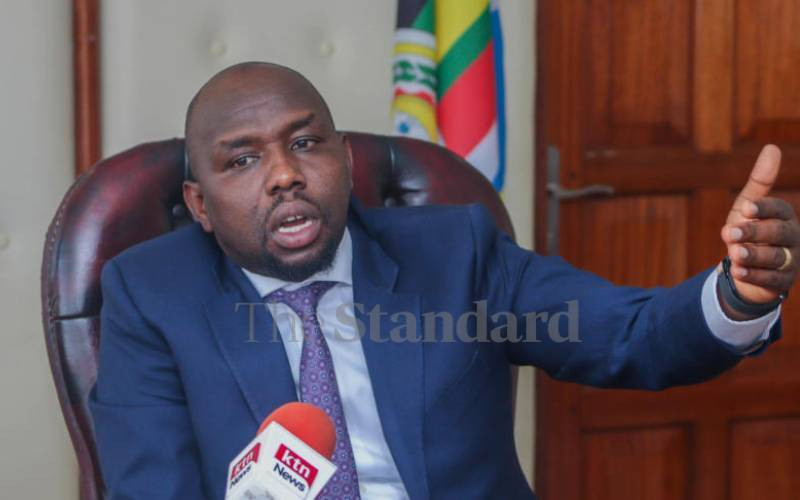 |
|
The wreckage of the ‘City to City’ bus that crashed in Ntulele, Narok County, on Wednesday night. [PHOTO:BONIFACE THUKU/STANDARD] |
By James Mbaka
Kenya: The deadly bus crash that killed 41 people in Narok has underscored the woes ailing the country’s traffic safety and brought into sharp focus the futile efforts by industry players to arrest runaway road carnage.
The country is now grappling with runaway road accidents despite having stringent laws meant to punish traffic offenders and put in checks to arrest road carnage.
Despite having several agencies charged with the responsibility of ensuring public service transport safety, many Kenyans continue to be victims of either the intertwined complacence within the sector’s authorities or driver recklessness.
The National Transport and Safety Authority (NTSA) is charged with addressing road safety challenges and improve the road transport sector through registration, inspection and licencing of motor vehicles, testing of drivers and all aspects of road safety in general.
The authority was launched in April to advise the government on matters relating to road transport and safety with an aim of reducing road accidents.
In collaboration with other stakeholders, the authority also ensures effective and safe operations within the road transport sector.
Although NTSA launched county transport and safety committees, many Kenyans still lose their lives through recklessness and unruly driving on roads. But, despite the authority being in place, significant hurdles remain and many deadly accidents go unreported
Although laws are very clear on matters of traffic and its relations, are they are just ‘contained in books’ or are they just there because they ought to be? Have road transport stakeholders substituted lives with money and irresponsibility?
These are some of the lingering questions after the Homa Bay-bound City to City bus flipped over, tearing off its roof, and killing 41 passengers on the Mai Mahiu-Narok road near Ntulele.
Despite punitive legislations for traffic offenders after the implementation of the Traffic (Amendment) Act 2012 and the National Transport and Safety Authority Act 2012, road accidents still kill many.
The two legislations were formulated with the intention of dealing with traffic offences, which account for over 25 per cent of accidents in the country.
Stiff penalties
The Traffic (Amendment) Act amended various sections of the Traffic Act in a move to enhance penalties for various traffic offences. Notably, every driver of a Public Service Vehicle (PSV) is now required to undergo a physical fitness test before being issued with a licence or having it renewed. They should also undergo compulsory tests after every three years to ascertain their competence.
The Traffic (Amendment) Act criminalises drunk driving as it proposes a stiffer penalty for those found guilty. Anyone convicted for drunk driving will be fined Sh500,000 or a 10-year jail term or both.
Stay informed. Subscribe to our newsletter
The law also demands that motorbike riders must possess driving licences, failure to which they will be fined Sh10,000 or jailed for a year or both
Driving without a licence attracts a tougher penalty as offenders will be jailed for 10 years or fined Sh500,000 or both.
However, the Matatu Owners Association termed the laws punitive saying they were meant to kill the sector.
In 2003, the late Transport Minister John Michuki reorganised the public transport sector through a raft of legislations that saw sanity restored on the roads.
The infamous Michuki rules did rid the sector of cartels and introduced badges for drivers and conductors alongside regulating passenger carrying capacity.
The vehicles were also fitted with speed governors and safety belts.
However, failure to ensure adherence in the post Michuki period raises questions of complacence with sector regulators.
In July, some 18 people, among them students, were killed when the school bus they were travelling in crashed in Kisii.
The students were travelling late into the evening for a sporting event at Nyamache District before their overloaded bus crashed.
In Wednesday’s incident, the police say the ‘City to City’ bus had no TLB licence and was overloaded. It had 77 passengers on board against its required capacity of 61.
In the two horror accidents, the drivers escaped with minor bruises raising questions on the nature of the accident.
Speaking after Wednesday’s accident, Traffic Commandant Samwel Kimaru said the driver appeared to have failed to negotiate the corner and that initial investigations showed no signs of the driver trying to engage brakes, indicating he would have been asleep.
“From our investigations, the driver did not even attempt to brake or negotiate the corner. He seemed to have slept,” Kimaru said of the driver who is believed to be alive and at large.
As the blame game as to who should be held responsible for the deaths take shape, the Law Society of Kenya has warned Kimaru that he risks losing his job over the runaway road accidents in the country.
According to the LSK, failure by the Traffic Commandant to enforce the Traffic Act has led to 1,731 deaths and 12,000 injuries through road accidents this year alone.
The LSK gave Kimaru a 30-day ultimatum to provide a comprehensive plan of action and steps taken to arrest road carnage and menace in the roads.
President Uhuru Kenyatta has also warned owners of public service vehicles that they will be held responsible for misconduct of their drivers.
 The Standard Group Plc is a
multi-media organization with investments in media platforms spanning newspaper
print operations, television, radio broadcasting, digital and online services. The
Standard Group is recognized as a leading multi-media house in Kenya with a key
influence in matters of national and international interest.
The Standard Group Plc is a
multi-media organization with investments in media platforms spanning newspaper
print operations, television, radio broadcasting, digital and online services. The
Standard Group is recognized as a leading multi-media house in Kenya with a key
influence in matters of national and international interest.
 The Standard Group Plc is a
multi-media organization with investments in media platforms spanning newspaper
print operations, television, radio broadcasting, digital and online services. The
Standard Group is recognized as a leading multi-media house in Kenya with a key
influence in matters of national and international interest.
The Standard Group Plc is a
multi-media organization with investments in media platforms spanning newspaper
print operations, television, radio broadcasting, digital and online services. The
Standard Group is recognized as a leading multi-media house in Kenya with a key
influence in matters of national and international interest.









